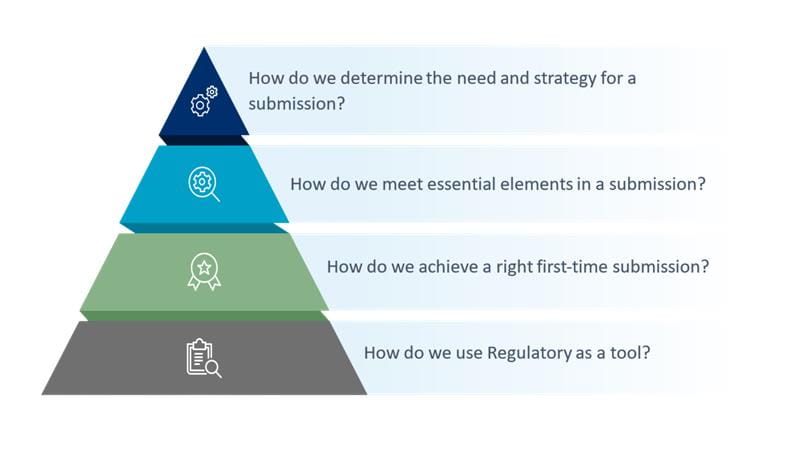Begin with the End in Mind: Defining a Pathway for Regulatory Success for Devices in Combination Products – Device Focus
Begin with the End in Mind and the Four “Hows” of Regulatory Success
To achieve a “right first time” submission, it is essential to clearly define the end goals of the regulatory submission. One of the most important goals of a submission is to support the patient or end user by ensuring that the device is accessible in the given market. A good regulatory submission proves that the device is both safe and effective for its intended use. Another goal to meet business needs requires establishing a straightforward path to the intended market, with minimal questions, which in turn expedites product delivery to the end user. While this might seem obvious, these goals can sometimes be overlooked during the progression of a project.

The Four “Hows” of Regulatory Success
One effective approach to maintain focus on these goals is to apply the Four "Hows" of Regulatory Success. This concept is similar to the well-known Five "Whys" root cause analysis technique used in Corrective and Preventive Action (CAPA) processes, which identifies the underlying cause of a problem by repeatedly asking "why." However, the Four "Hows" of Regulatory Success guide teams to collaborate cross-functionally and engage Regulatory Affairs to navigate evolving regulations and overcome any challenges that may arise. The Four "Hows" are depicted in the image below, and this discussion will explore how to effectively answer these questions
HOW: Determining the Need and Strategy for a Submission
External Collaboration
As a device or drug manufacturer, particularly for co-packaged and/or combination products, it is imperative to collaborate early with the external partner involved. A simple and mandatory way to establish and define responsibilities of both the drug and device manufacturer is to draft and execute a quality agreement. Quality agreements between manufacturers of each constituent part of the product help ensure compliance, transparency, and communication for the overall product by defining each party’s roles and responsibilities, detailing frequency of required communications, providing responsibilities surrounding internal and external audits, among other aspects.
Moreover, this phase of the process serves as an opportunity to establish expectations between the drug and device manufacturers for specific projects and/or products. This is particularly important when a new project is proposed, as discussions should cover specific topics such as the intended use, device, drug, claims, target markets, and project timelines. Ensuring these expectations are thoroughly communicated and agreed upon can help streamline collaboration and enhance project success.
Internal Collaboration
Whether there is a new project initiated between device and drug manufacturers, or a change is proposed internally, cross-functional teams must collaborate and involve regulatory affairs early. Initially, regulatory affairs provides vital information to support registration strategies for various global markets.
Changes throughout the product’s lifecycle must be carefully evaluated to determine risks to the product’s intended use, safety, and effectiveness and to understand the implications for the applicable market regulations and guidance documents. Because of this, the change management process provides an excellent opportunity for awareness and continuous improvement. A collapse in the change management process could result in serious consequences or delays in registrations with regulatory authorities.
Once a change has been evaluated, Regulatory Affairs can formulate the submission strategy, e.g. a new submission, change submission, or documentation for filing. Contingent on the type of change, Regulatory Affairs may need to classify a product. For example, an existing medical device sold on its own in which a change is made for the device to be co-packaged with a drug product, will be classified differently than the device on its own. Depending on the type and classification of the device or product, the strategy of the submission could vary. By involving Regulatory Affairs from the onset, the strategy can be thoroughly planned to maximize both efficiency and compliance.
HOW: Understanding and Meeting Essential Elements of a Submission
Understanding and adhering to the regulatory requirements of the intended market are essential for the success of a submission. Below is an overview of the regulatory pathways for the United States Food and Drug Administration (US FDA) regarding devices and drugs, as well as the European Union (EU) Device and Medicinal legislation. It is important to understand that each market is unique, and regulations and requirements may be differ vastly for device, drug, or combination product registration.
US FDA Device and/or Drug Submissions
In the United States, multiple regulatory pathways exist based on the product's primary mode of action, whether it is device-led or drug (or biologic)-led. A device-led submission is when the primary mode of action of the product is the medical device, while a drug led product has the drug as the primary mode of action.
For device-led submissions, some pathways include FDA 510(k) Premarket Notification, Premarket Approval (PMA), De Novo, Humanitarian Device Exemption (HDE), Requests for Information (513(g) Request), Breakthrough Device Designation Request, Pre-Submission (Q-Sub), and Investigational Device Exemption (IDE). Some premarket submissions, like 510(k)s, are compiled in accordance with the structure recommended by the pathway selected, and the submission package is submitted to the Center for Devices and Radiological Health (CDRH) for review and clearance. Other submissions, like Q-Subs, are submitted for clarification purposes or feedback only.
In the case of drug-led submissions, possible pathways include Investigational New Drug Application (IND), New Drug Application (NDA), Abbreviated New Drug Application (ANDA), Biologic License Application (BLA), Over-the-Counter (OTC) Monograph Drug Process, Emergency Use Authorizations, and Orphan Drug Designations. These submissions are compiled in accordance with the structure recommended by the pathway selected, and the submission package is submitted to either the Center for Drug Evaluation and Research (CDER) or the Center for Biologics Evaluation and Research (CBER) for review and approval.
Additionally, separate submissions for each component of the combination product may be necessary, depending on the regulatory strategy established in conjunction with the cross-functional teams or with the drug or device partner, as discussed previously. Once the pathway is determined, Regulatory Affairs can proceed with crafting the submission.
EU Device and Medicinal Submissions
In contrast, the European Union provides fewer pathway options for obtaining market approval, and the approval process is distinctly different due to regulations and directives that set the expectations and requirements for a submission. Devices are regulated under Regulation (EU) 2017/745, known as the Medical Devices Regulation (EU MDR), and device submissions are reviewed and approved by Notified Bodies. Drugs fall under Directive 2001/83/EC for Medicinal Products for Human Use and are reviewed and approved by the European Medicines Agency (EMA). For combination products that involve both a device and a drug, compliance with both Regulation 2017/745 and Directive 2001/83/EC is required.
HOW: Achieving a “Right First Time” Submission
Achieving a "Right First Time" submission can be accomplished through various strategies, which may differ depending on the business's specific needs, deadlines, submission pathway, and the type or objective of the submission.
Pro-Active Preparation
Proactive efforts by manufacturers can lead to more comprehensive and compliant submissions. Investing extra effort at the beginning can save time and resources, making it a worthwhile investment. Key proactive activities include:
- Fostering continuous collaboration between drug and device manufacturers
- Conducting horizon scanning and assessing emerging regulations and revised standards
- Implementing lessons learned from previous submissions
- Identifying regulatory body trends and focus areas
- Being prepared to respond quickly to questions, requests or inquiries
Objective Evidence & Authoring the Submission
Objective evidence and the submission package should be clear, thorough, and well understood. To facilitate this, consider the following:
- Author should set the reviewer up for success by leading them through the report the way the author intends it to be interpreted.
- All documents, including protocols, reports, and attachment should be clear and understandable, even to individuals not directly involved with the project (e.g., Regulatory Affairs and the Agencies).
- Objective evidence should address all aspects of the technical requirement and applicable regulations or standards.
- All documentation and reports must be translated to English, noting that some markets require additional translations and some agencies have specific page size requirements (e.g., Letter vs. A4).
- Ensure any included images are clear and not blurry.
- Reports should be streamlined and concise.
- Feedback from cross-functional teams regarding document content errors or missing documents should be addressed promptly and without delay.
Rationales and Back-Up Plans
Throughout a project or when drafting a submission, obstacles may arise. For example, testing might be redundant, may not be appropriate based on the specifics of the drug/device combination, or there may be a non-significant failure in a functionality test. In such cases, rationales or justifications may be utilized, but it is crucial to have a backup plan, such as concurrent re-testing. Justifications and rationales should be used judiciously, always maintaining patient safety and device effectiveness as the primary focus. Manufacturers should have a back-up plan ready in case of rejection.
HOW: Utilizing Regulatory Affairs to Full Potential
Regulatory affairs should be regarded as a valuable partner. Historically, regulatory professionals might have been perceived as obstacles, but they are now actively working to dismantle these barriers. Ultimately, regulatory affairs wants to have good quality products placed in the market while ensuring compliance to not only enter the given market successfully but remain in the market for the product’s entire lifecycle.
Proficient regulatory affairs professionals possess several key qualities, such as being effective communicators, masterful organizers, proficient negotiators, and continuous learners. They are culturally aware and bring extensive regulatory expertise to their roles. Engaging with regulatory affairs early in the process is crucial. It is important to embrace change and navigate obstacles together, understanding that regulatory professionals aim to foster a solution-oriented relationship, which is vital for ensuring the success of both the company and its submissions.
Key Takeaways
- Collaboration between drug and device manufacturers are essential for co-packaged combination and combination drug/device submissions.
- Evaluate and strategize early with internal and external stakeholders, and don’t forget to reach out to regulatory affairs.
- Understanding agency and market requirements in the beginning of a project help improve submission content and submission timelines.
- Objective evidence to support submissions should be clear and concise. Effort spent up-front can save time and resources, making it well-worth the investment.
- Regulatory affairs professionals and the regulatory affairs department serve as an invaluable resource in a product's market strategy and lifecycle management. Regulatory exists to ensure patient safety, enforce regulatory compliance, and support the business's objectives.



